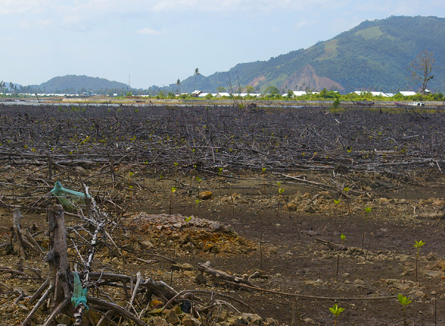Field studies of an Indonesian coastline ravaged by a tsunami in December 2004 suggest that leaving mangrove forests intact along a shoreline could substantially reduce damage from moderate-sized tsunamis.

When a magnitude 9.1 earthquake struck west of Sumatra on December 26, 2004, it spawned a tsunami that hammered nations fringing the Indian Ocean (SN: 1/8/05, p. 19). Near Banda Aceh, Indonesia, on the northwestern tip of Sumatra, the tsunami swept inland more than 4 kilometers and killed tens of thousands of people. Now, by studying wave-induced damage to the mangrove forests surrounding that city, civil engineer Shunichi Koshimura of Tohoku University in Sendai, Japan, and his colleagues have developed a model to estimate the tsunami-buffering capacity of intact mangrove forests. They report their findings online June 30 in the Journal of Geophysical Research–Oceans.
About two years after the damage occurred, the researchers took measurements of almost 700 mangrove trees in five broad swaths of intertidal terrain where dense stands of those trees — from the genus Rhizophora — had stood before the tsunami struck. Many of those trees were damaged, snapped off near their bases by the surging water, but some had survived the inundation unscathed. The team’s analyses showed that as the estimated wave-induced stresses on tree trunks increased, the proportion of damaged trees also increased.
Using that data, Koshimura and his colleagues calculated how well intact forests of mangroves — and especially the dense, broad networks of thick roots that prop up the trees’ trunks — might absorb the coast-battering energy in tsunamis of various heights.
The researchers estimate that a 500-meter-wide swath of 10-year-old mangroves — a forest in which each 10 square meters of land contains about 16 trees, and tree trunks average about 7 centimeters in diameter — would reduce the force of flowing water in a 3-meter-deep tsunami by 70 percent. For a 4-meter-deep tsunami, however, that same forest would be mostly destroyed by the surging water.
Older trees fare better against the battering waves, the team suggests. More than 80 percent of the trees in a 500-meter-wide patch of 30-year-old mangroves could survive a 5-meter-deep tsunami and absorb half the hydrodynamic force exerted by the onshore surge.
“Mangroves make an effective bioshield against tsunamis,” says Koshimura. “It is not possible to build concrete walls along all the coasts,” he notes. He adds, though, that his team’s analyses suggest a 6- to 9-meter-deep tsunami would destroy even a mature mangrove forest.
Koshimura and his team “have really provided a solid set of data and analyses… that show the damage-reducing effects of mangroves,” says Monte Sanford, a Reno, Nev., environmental consultant formerly at the University of Nevada. “It’s refreshing to see this, because for the past six years there have been two different camps about whether mangroves actually help reduce damage.”





